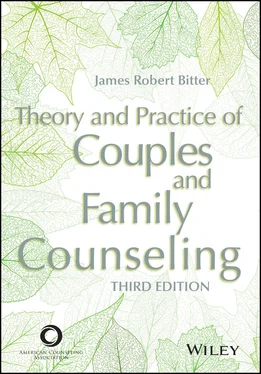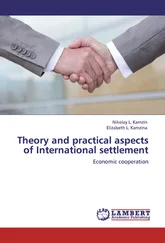James Robert Bitter - Theory and Practice of Couples and Family Counseling
Здесь есть возможность читать онлайн «James Robert Bitter - Theory and Practice of Couples and Family Counseling» — ознакомительный отрывок электронной книги совершенно бесплатно, а после прочтения отрывка купить полную версию. В некоторых случаях можно слушать аудио, скачать через торрент в формате fb2 и присутствует краткое содержание. Жанр: unrecognised, на английском языке. Описание произведения, (предисловие) а так же отзывы посетителей доступны на портале библиотеки ЛибКат.
- Название:Theory and Practice of Couples and Family Counseling
- Автор:
- Жанр:
- Год:неизвестен
- ISBN:нет данных
- Рейтинг книги:5 / 5. Голосов: 1
-
Избранное:Добавить в избранное
- Отзывы:
-
Ваша оценка:
- 100
- 1
- 2
- 3
- 4
- 5
Theory and Practice of Couples and Family Counseling: краткое содержание, описание и аннотация
Предлагаем к чтению аннотацию, описание, краткое содержание или предисловие (зависит от того, что написал сам автор книги «Theory and Practice of Couples and Family Counseling»). Если вы не нашли необходимую информацию о книге — напишите в комментариях, мы постараемся отыскать её.
Theory and Practice of Couples and Family Counseling — читать онлайн ознакомительный отрывок
Ниже представлен текст книги, разбитый по страницам. Система сохранения места последней прочитанной страницы, позволяет с удобством читать онлайн бесплатно книгу «Theory and Practice of Couples and Family Counseling», без необходимости каждый раз заново искать на чём Вы остановились. Поставьте закладку, и сможете в любой момент перейти на страницу, на которой закончили чтение.
Интервал:
Закладка:
Having a sincere interest in the welfare of others. What effective family practitioners initially bring to counseling is a focused interest on the family and its members. They want to get to know the family, to feel their way in as Carl Whitaker suggested (Whitaker & Bumberry, 1988). Eventually they may come to care about the family members they see, but even before that caring develops, they are interested in the welfare of their clients. Effective family practitioners know that the kind of relationship they form with the family and its members has a greater impact than whatever techniques or interventions are used (Carlson et al., 2005).
Tending the spirit of the family and its members. Tending the spirit is about creating and maintaining meaning and the connections among family members that support that meaning. Harry Aponte (1994) has most directly integrated meaning, spirit, and family systems interventions, but we can also find an emphasis on tending the spirit of the family in the family violence work of Cloe Madanes (1990). Adlerians emphasize the development of a community feeling and social interest in families. Feminists remind us of the importance of the female spirit, and social constructionists emphasize the meaning that is coconstructed in counseling and therapy as well as in family life. Tending to the spirit of the family is part of the evolution of the field that has reinserted human issues into the processes of family systems work.
Involvement, engagement, and satisfaction in working with families. Effective family practitioners love the involvement and engagement of working with the family as a unit. They find satisfaction in working with the issues of intimacy, contact, rituals, and routines of family life. They see families and the world in terms of the interactions and transactions that take place. They see family life as developmental and are prepared to facilitate family transitions. In short, family practitioners are effective because they are interested in and excited about the possibilities for wellness and resilience that family work provides.
The Process of Change and Therapeutic Process
In one sense, change is inevitable: It is life. From the moment we are conceived until long after we die, we change. Where there is no change, there is simply no life. Change is also something that happens both internally and externally. When we talk about changing internally, we are considering the human capacities for adapting, adjusting, and taking a different stance. But change also happens in the world, and it has real effects on the lives of people. External change and its effects may be easiest to see in natural disasters when, for example, certain structures or places we have come to know and trust are simply wiped out of existence (as in a tornado or a hurricane). In families, losing a job, divorcing, adding children, moving to a new location, starting school, and leaving home are all examples of changes that affect the family and its members.
Each of the models we will study approaches the process of change somewhat differently. All of them contribute something to an understanding of how change occurs and how people adapt to changes in their lives. For now, however, let me use Satir’s description of the process of change to orient us to what can happen in family counseling. Satir believed that the patterns and routines people create to make their lives functional achieve a kind of normalcy she called the family’s status quo . People tend to stay in their patterns and routines until their lives are disrupted by an outside force she called a foreign element . It is the disruption of our patterns and routines that sends both the family and its members into chaos, the feeling that comes with being disoriented and unable to focus. In chaos, everything seems overwhelming, unsafe, and out of balance. If people are able to regain a sense of balance and safety, if they are able to right themselves and feel their feet back on the ground, they often are able to create or discover new possibilities, to change course, or to adapt. Whatever works will, over time, become a new integration, a new set of patterns and routines, and a new status quo (Pelonis, 2002; Satir & Baldwin, 1983; Satir et al., 1991).
Of course, family practitioners tend to meet families when they are in chaos. The family may want to make major decisions in an effort to reduce the pain of the problems they face, but this is usually a mistake. In the beginning, exploration is usually a much more important intervention than problem-solving. Discovering who the people are and why they are seeking help provides focus as well as goals for counseling. I believe the single most important thing that you can do when a family is in chaos is stay present and listen. The first tasks of family practice are almost always to form a relationship with the family and begin an assessment. Monica McGoldrick (2016), for example, is highly effective at using genograms as an avenue to forming an exploratory relationship with couples and families (see McGoldrick, 2018).
Although the ultimate end of counseling may be the facilitation of change, each model will have different ways of achieving that end. In the chapters that follow, you will read about change processes that involve coaching, nurturing, sculpting, educating, experiencing, enacting, directing and indirecting, focusing on solutions, coconstructing preferred outcomes, and even training for more effective living. Almost none of the models we will study advocate change for the sake of change. The ends these approaches seek may be varied in description and process, but there are some general guidelines:
It is better for families to rediscover their connections than to be left in disarray and disengagement.
It is better to remove constrictions from systems and allow people to experience life more fully than to leave them in protective states.
It is better for systems to be organized than disorganized.
It is better for communication to be open, congruent, and responsive than to be closed, defensive, or dismissive.
It is better to say what we think and feel about things that matter than to be lost in silence.
It is better to set limits, define a bottom line, and clarify what we can do and give than to be controlled by others.
It is better for people to think rationally than irrationally.
It is better to know than not to know.
It is better for people to feel something than to feel nothing at all.
It is better for people to act and take a chance than to become immobilized or constricted.
It is better to have goals and hope than to be discouraged.
It is better to have access to a greater number of internal parts than just a few.
It is better to be appreciative of one’s gender, culture, and ethnicity than to reject it or be cut off from it.
It is better for people to risk optimism, faith, and courage than to live in fear.
Of course, there are exceptions to every one of these generalities. But taken together, they point toward growth, development, organization, meaningfulness, increased opportunities, wider and varied experiences, and augmented capacities and strengths. Which of these guidelines might inform your goals in working with families? Are there additional guidelines you could offer? Are there some that do not fit for you at all? Envisioning where you are going with a family is essential to getting there.
Beginning Your Work as a Couples or Family Practitioner
There are actually some people who seem to be born counselors when they are working with individuals. Such people listen extremely well, bring a focused interest to most of their therapeutic relationships, and have what appears to be a natural capacity for expressing empathy. However, we all tend to have difficulties when we first start working with families. Listening well to family members without paying attention to family process can actually get us lost. Disorganized families often seem chaotic. Learning to think and work systemically is not easy: It takes time and practice.
Читать дальшеИнтервал:
Закладка:
Похожие книги на «Theory and Practice of Couples and Family Counseling»
Представляем Вашему вниманию похожие книги на «Theory and Practice of Couples and Family Counseling» списком для выбора. Мы отобрали схожую по названию и смыслу литературу в надежде предоставить читателям больше вариантов отыскать новые, интересные, ещё непрочитанные произведения.
Обсуждение, отзывы о книге «Theory and Practice of Couples and Family Counseling» и просто собственные мнения читателей. Оставьте ваши комментарии, напишите, что Вы думаете о произведении, его смысле или главных героях. Укажите что конкретно понравилось, а что нет, и почему Вы так считаете.












